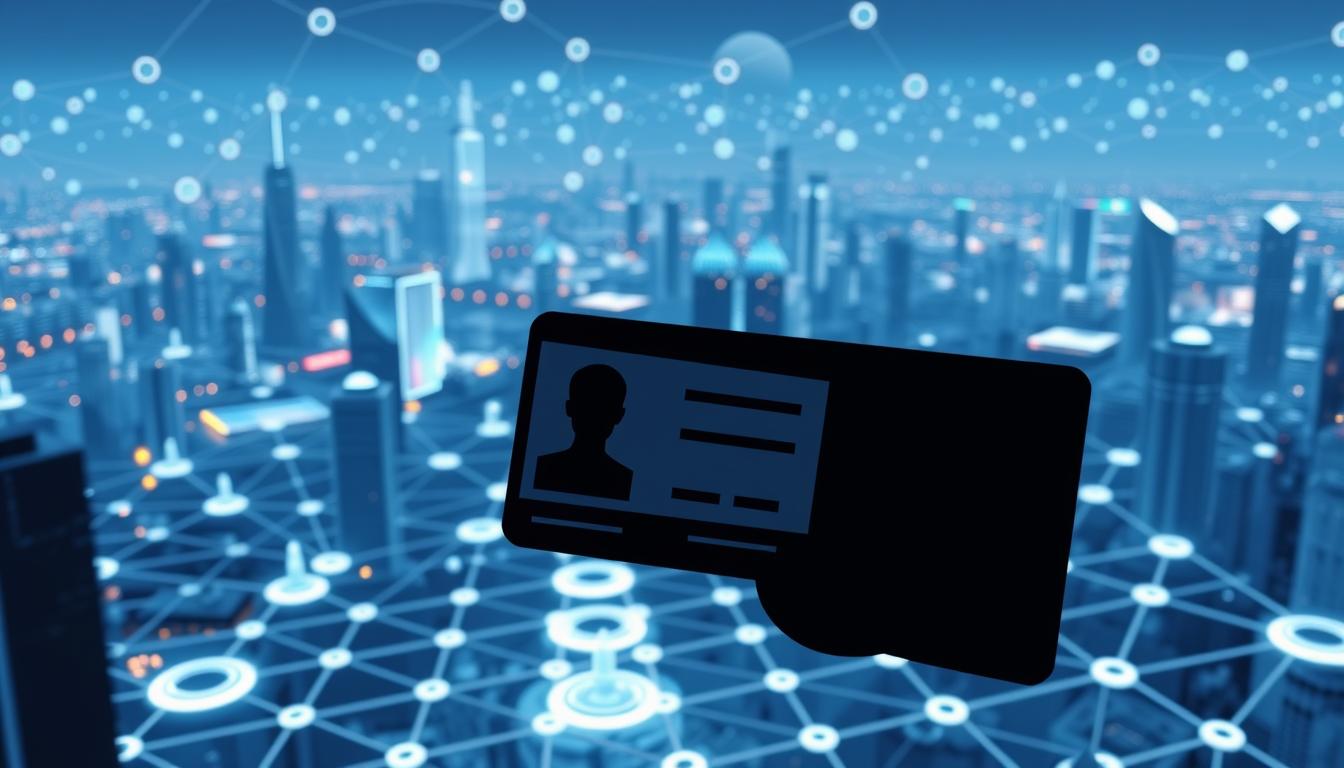Now Reading: Blockchain Identity Verification: Secure Authentication Methods
- 01
Blockchain Identity Verification: Secure Authentication Methods
Blockchain Identity Verification: Secure Authentication Methods

Over 1.1 billion people globally lack official proof of who they are. This gap locks them out of basic rights like banking, voting, or owning property. Existing methods for managing personal data depend on vulnerable centralized servers, which hackers target relentlessly. In 2018 alone, breaches exposed nearly 3 billion records – costing over $650 billion.
Traditional systems force users to surrender control of their information to third parties. These setups create weak spots for cyberattacks and accidental leaks. A single compromised database can spill sensitive details like Social Security numbers or medical histories.
New approaches now let individuals manage their own credentials without middlemen. Through advanced cryptography and shared networks, users decide exactly what to share – and with whom. This shift reduces fraud risks while simplifying access to services across industries.
Key Takeaways
- 1.1 billion people lack access to official identification worldwide
- Centralized data storage creates security risks and exclusion
- Decentralized networks empower users to control personal information
- Cryptographic methods prevent tampering with sensitive records
- Modern solutions improve privacy across finance, healthcare, and education
Navigating Today’s Identity Verification Challenges
Modern authentication struggles under the weight of 22 billion connected devices by 2025 – each needing secure access controls. Current methods weren’t built for this scale, creating cracks where fraudsters slip through.

Risks in Traditional Systems
Centralized databases act like treasure chests for hackers. When one gets breached, attackers gain keys to Social Security numbers, addresses, and financial records. This explains why 97% of leaks involve personal information – a statistic that keeps CISOs awake at night.
Users juggle 70-80 passwords on average, creating weak spots through reused credentials. For enterprises, GDPR fines can reach €20 million when these cracks widen. Compliance costs now rival cybersecurity budgets.
Impact on Individuals and Enterprises
Every stolen credit card costs businesses $150 in recovery fees. For individuals, identity theft takes 200+ hours to resolve. Smart thermostats and factory sensors compound these risks – 83% of IoT devices lack proper authentication safeguards.
Financial institutions spend $48 million yearly on KYC checks that still fail to stop synthetic fraud. The solution lies in rethinking how we manage credentials, not just adding more security layers.
Blockchain Identity Verification: A New Paradigm in Secure Authentication
The digital age demands a radical rethink of how we prove who we are. Traditional methods struggle with security gaps and exclusion, leaving billions vulnerable. Emerging solutions now empower users through cryptographic tools and shared networks, fundamentally changing authentication dynamics.

What Is This New Approach?
At its core, this system replaces centralized databases with user-controlled credentials. People create unique digital identifiers secured by advanced cryptography, stored across distributed networks. These identifiers let individuals share only necessary details – like confirming their age without revealing birthdates.
Core Advantages
Three critical improvements define modern authentication:
- User ownership of personal data through self-managed profiles
- Fraud-resistant records that update in real time across networks
- Global accessibility without reliance on government-issued documents
This framework combines mathematical security with user-friendly design. Cryptographic proofs validate information without exposing raw data, while distributed ledgers prevent backdated alterations. For enterprises, it slashes compliance costs and breach risks simultaneously.
Adoption grows as industries recognize the privacy-enhancing solutions these systems provide. From healthcare to finance, organizations now authenticate users without maintaining vulnerable data troves. The shift marks a turning point in digital trust – one where individuals finally control their virtual presence.
How Decentralized Identities and Smart Contracts Empower Users
Digital interactions now demand systems where people retain authority over their credentials. Traditional setups force reliance on intermediaries that slow processes and increase breach risks. Modern frameworks combine self-managed profiles with automated validations to shift power back to individuals.

The Role of Smart Contracts in Authentication
Self-executing code revolutionizes how systems confirm legitimacy. These digital agreements analyze credentials against preset rules, approving access in seconds. For example, a banking app could instantly verify income documents using logic embedded in its platform.
Trust scores update dynamically based on behavior patterns and data consistency. This eliminates manual reviews while reducing fraud opportunities. Enterprises save up to 70% on compliance costs by automating checks through cryptographic proofs.
User Empowerment through Decentralized Identity Models
Individuals now manage multiple personas for different services. A gaming profile stays separate from healthcare records, preventing unwanted data cross-pollination. Each persona operates through unique cryptographic keys that only the owner controls.
Three critical benefits emerge:
- Granular consent settings for sharing specific data points
- Real-time revocation of access permissions
- Tamper-proof activity logs across all interactions
This structure lets people prove qualifications without exposing sensitive details. A job applicant could confirm degrees without sharing birthdates or addresses. As adoption grows, these models redefine digital trust at scale.
Leveraging Blockchain Technology for Enhanced Data Security
Modern enterprises face escalating threats to sensitive records, with 68% of business leaders citing data breaches as their top operational risk. Emerging frameworks now combine cryptographic protocols with distributed networks to address these vulnerabilities head-on.
Revolutionizing Key Management Systems
Traditional certificate authorities create single points of failure in digital trust systems. Decentralized Public Key Infrastructure (DPKI) enables organizations to anchor encryption keys directly on immutable ledgers. This approach eliminates third-party risks while maintaining chronological order for audit trails.
Financial institutions using DPKI report 40% fewer phishing incidents due to real-time key validation. The system automatically flags compromised credentials before attackers exploit them.
Strengthening Information Safeguards
Distributed storage solutions fragment personal records across multiple nodes using advanced encryption. Healthcare providers adopting these methods reduced exposure risks by 83% compared to centralized databases.
Three critical benefits emerge:
- No single breach point for hackers to target
- Automatic updates across all network participants
- User-controlled access permissions through cryptographic proofs
Companies implementing enhanced security frameworks achieve 92% faster compliance audits. These systems prove particularly effective in sectors handling sensitive consumer information like finance and education.
Innovative Use Cases Across Industries
Connected devices now outnumber humans 9-to-1, creating urgent demand for scalable security solutions. Industries from entertainment to banking are adopting new authentication frameworks to address this challenge while improving customer experiences.
Powering Next-Gen Digital Experiences
Gaming platforms now deploy tamper-proof player profiles that work across multiple titles. These systems prevent account takeovers while letting users transfer achievements between ecosystems. Players control what personal data gets shared – a critical feature as virtual economies grow.
IoT networks manage 25% more devices annually, requiring robust authentication processes. Smart factories use decentralized systems to verify sensors and robots automatically. This prevents unauthorized access to production lines while enabling real-time data exchanges.
Transforming Financial Inclusion
Major banks now complete loan approvals in 8 minutes instead of 8 days using automated checks. Southeast Asian institutions reduced KYC costs by 76% while serving 12 million previously unbanked customers. McKinsey projects these changes could triple regional economic growth tied to digital services by 2030.
Three sectors show particularly strong results:
- Healthcare: Secure patient portals with cross-hospital compatibility
- Logistics: Immutable product tracking from factory to shelf
- Education: Portable academic credentials resistant to forgery
These use cases prove decentralized systems solve real-world problems beyond theoretical applications. As adoption spreads, they redefine how organizations and individuals interact in digital spaces.
Steps to Implement Secure Blockchain Authentication Methods
Organizations seeking robust data protection must follow structured deployment strategies. Effective implementation combines technical infrastructure with user-centric design principles to balance security and accessibility.
Building the Foundation
Application setup starts with mobile apps distributed through trusted platforms. Users receive unique digital IDs that replace traditional passwords. Government documents get stored in decentralized networks using cryptographic hashes – ensuring privacy without compromising accessibility.
Smart Credential Evaluation
Automated systems analyze document quality and information consistency to generate trust scores. New users undergo six-month evaluation periods to establish credibility. Third-party requests trigger instant notifications, with approvals recorded through tamper-proof systems.
Best practices include regular audits of compliance protocols and real-time updates to validation algorithms. Enterprises adopting this approach report 62% faster onboarding while maintaining strict data management standards. These methods prove particularly effective in finance and healthcare sectors requiring high-security solutions.
FAQ
How do decentralized systems improve security compared to traditional methods?
Unlike centralized databases vulnerable to breaches, decentralized models distribute data across networks, reducing single points of failure. Encryption and user-controlled access minimize unauthorized exposure, enhancing protection against cyberattacks.
Can individuals truly own and manage their digital credentials without intermediaries?
Yes. Self-sovereign frameworks enable people to store credentials locally or in encrypted wallets. Permissions are granted via cryptographic keys, allowing selective sharing without relying on third-party validators.
What industries benefit most from tamper-proof authentication solutions?
Banking, healthcare, and IoT sectors gain from immutable audit trails. For example, financial platforms like IBM Blockchain verify transactions securely, while healthcare systems like MedRec protect patient records through permissioned access.
How do smart contracts streamline compliance processes?
Automated scripts enforce predefined rules, instantly validating credentials against regulatory standards. This reduces manual checks, accelerates KYC workflows, and ensures consistent adherence to policies like GDPR or HIPAA.
Are decentralized storage solutions scalable for global enterprises?
Distributed networks like IPFS or Filecoin handle large datasets efficiently. Enterprises such as Microsoft Azure leverage these systems for resilient, cost-effective data management without compromising speed or accessibility.
What prevents misuse of personal details in peer-to-peer ecosystems?
Zero-knowledge proofs allow verification without revealing raw data. Platforms like Polygon ID use this method to confirm user eligibility while keeping sensitive information private and secure.













